SKODA FABIA 2004 1.G / 6Y Owner's Manual
Manufacturer: SKODA, Model Year: 2004, Model line: FABIA, Model: SKODA FABIA 2004 1.G / 6YPages: 247
Page 151 of 247

Transporting children safely
150
Page 152 of 247
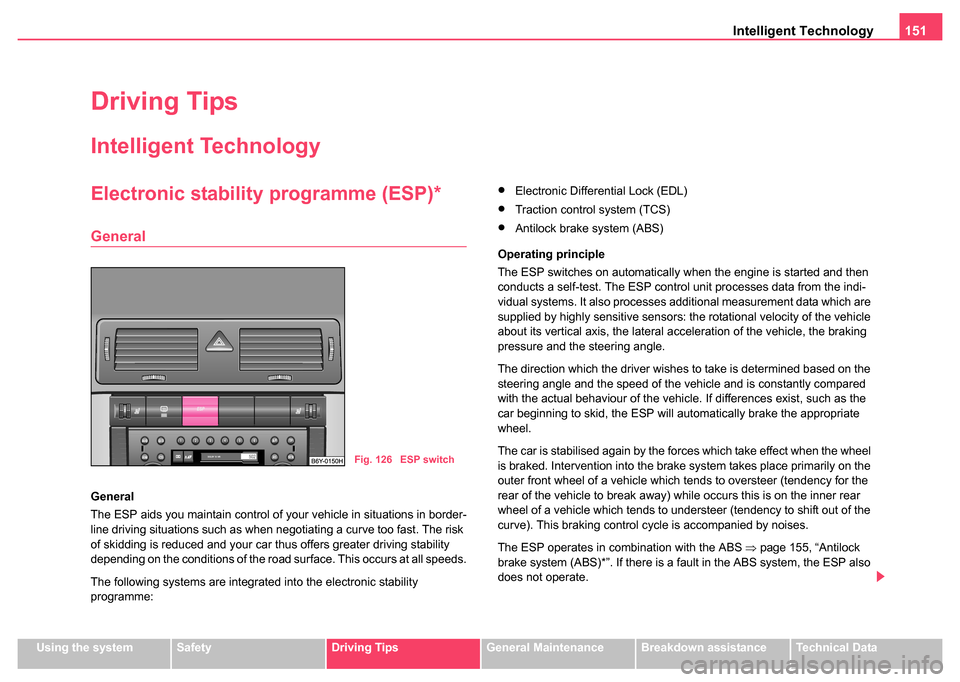
Intelligent Technology151
Using the systemSafetyDriving TipsGeneral MaintenanceBreakdown assistanceTechnical Data
Driving Tips
Intelligent Technology
Electronic stability programme (ESP)*
General
General
The ESP aids you maintain control of your vehicle in situations in border-
line driving situations such as when negotiating a curve too fast. The risk
of skidding is reduced and your car thus offers greater driving stability
depending on the conditions of the road surface. This occurs at all speeds.
The following systems are integrated into the electronic stability
programme:
•Electronic Differential Lock (EDL)
•Traction control system (TCS)
•Antilock brake system (ABS)
Operating principle
The ESP switches on automatically when the engine is started and then
conducts a self-test. The ESP control unit processes data from the indi-
vidual systems. It also processes additional measurement data which are
supplied by highly sensitive sensors: the rotational velocity of the vehicle
about its vertical axis, the lateral acceleration of the vehicle, the braking
pressure and the steering angle.
The direction which the driver wishes to take is determined based on the
steering angle and the speed of the vehicle and is constantly compared
with the actual behaviour of the vehicle. If differences exist, such as the
car beginning to skid, the ESP will automatically brake the appropriate
wheel.
The car is stabilised again by the forces which take effect when the wheel
is braked. Intervention into the brake system takes place primarily on the
outer front wheel of a vehicle which tends to oversteer (tendency for the
rear of the vehicle to break away) while occurs this is on the inner rear
wheel of a vehicle which tends to understeer (tendency to shift out of the
curve). This braking control cycle is accompanied by noises.
The ESP operates in combination with the ABS ⇒page 155, “Antilock
brake system (ABS)*”. If there is a fault in the ABS system, the ESP also
does not operate.
Fig. 126 ESP switch
Page 153 of 247
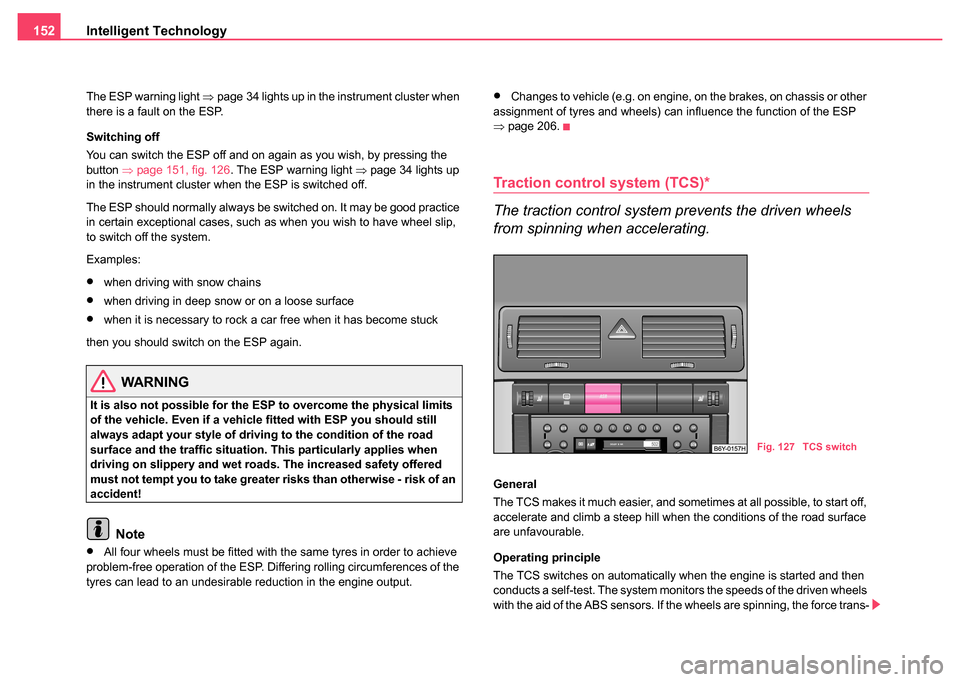
Intelligent Technology
152
The ESP warning light ⇒page 34 lights up in the instrument cluster when
there is a fault on the ESP.
Switching off
You can switch the ESP off and on again as you wish, by pressing the
button ⇒page 151, fig. 126 . The ESP warning light ⇒ page 34 lights up
in the instrument cluster when the ESP is switched off.
The ESP should normally always be switched on. It may be good practice
in certain exceptional cases, such as when you wish to have wheel slip,
to switch off the system.
Examples:
•when driving with snow chains
•when driving in deep snow or on a loose surface
•when it is necessary to rock a car free when it has become stuck
then you should switch on the ESP again.
WARNING
It is also not possible for the E SP to overcome the physical limits
of the vehicle. Even if a vehicle fitted with ESP you should still
always adapt your style of driving to the condition of the road
surface and the traffic situation. This particularly applies when
driving on slippery and wet roads. The increased safety offered
must not tempt you to take greater risks than otherwise - risk of an
accident!
Note
•All four wheels must be fitted with the same tyres in order to achieve
problem-free operation of the ESP. Differing rolling circumferences of the
tyres can lead to an undesirable reduction in the engine output.
•Changes to vehicle (e.g. on engine, on the brakes, on chassis or other
assignment of tyres and wheels) can influence the function of the ESP
⇒ page 206.
Traction control system (TCS)*
The traction control system prevents the driven wheels
from spinning when accelerating.
General
The TCS makes it much easier, and sometimes at all possible, to start off,
accelerate and climb a steep hill when the conditions of the road surface
are unfavourable.
Operating principle
The TCS switches on automatically when the engine is started and then
conducts a self-test. The system monitors the speeds of the driven wheels
with the aid of the ABS sensors. If the wheels are spinning, the force trans-
Fig. 127 TCS switch
Page 154 of 247
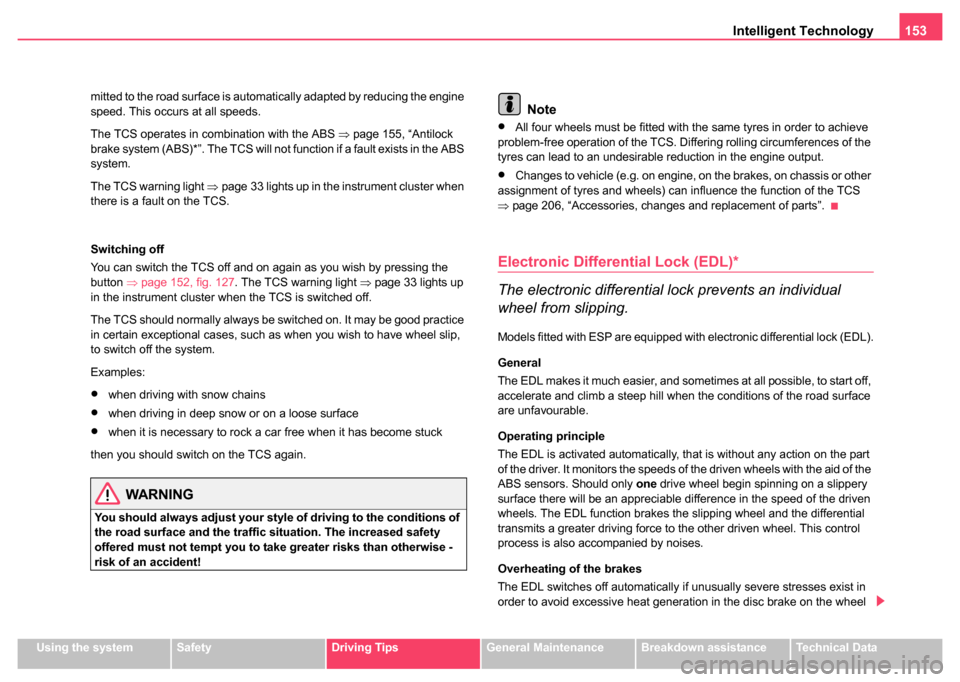
Intelligent Technology153
Using the systemSafetyDriving TipsGeneral MaintenanceBreakdown assistanceTechnical Data
mitted to the road surface is automatically adapted by reducing the engine
speed. This occurs at all speeds.
The TCS operates in combination with the ABS
⇒page 155, “Antilock
brake system (ABS)*”. The TCS will not f unction if a fault exists in the ABS
system.
The TCS warning light ⇒page 33 lights up in the instrument cluster when
there is a fault on the TCS.
Switching off
You can switch the TCS off and on again as you wish by pressing the
button ⇒page 152, fig. 127 . The TCS warning light ⇒page 33 lights up
in the instrument cluster when the TCS is switched off.
The TCS should normally always be switched on. It may be good practice
in certain exceptional cases, such as when you wish to have wheel slip,
to switch off the system.
Examples:
•when driving with snow chains
•when driving in deep snow or on a loose surface
•when it is necessary to rock a car free when it has become stuck
then you should switch on the TCS again.
WARNING
You should always adjust your style of driving to the conditions of
the road surface and the traffic situation. The increased safety
offered must not tempt you to take greater risks than otherwise -
risk of an accident!
Note
•All four wheels must be fitted with the same tyres in order to achieve
problem-free operation of the TCS. Differing rolling circumferences of the
tyres can lead to an undesirable reduction in the engine output.
•Changes to vehicle (e.g. on engine, on the brakes, on chassis or other
assignment of tyres and wheels) can influence the function of the TCS
⇒ page 206, “Accessories, changes and replacement of parts”.
Electronic Differential Lock (EDL)*
The electronic differential lock prevents an individual
wheel from slipping.
Models fitted with ESP are equipped with electronic differential lock (EDL).
General
The EDL makes it much easier, and sometimes at all possible, to start off,
accelerate and climb a steep hill when the conditions of the road surface
are unfavourable.
Operating principle
The EDL is activated automatically, that is without any action on the part
of the driver. It monitors the speeds of the driven wheels with the aid of the
ABS sensors. Should only one drive wheel begin spinning on a slippery
surface there will be an appreciable difference in the speed of the driven
wheels. The EDL function brakes the slipping wheel and the differential
transmits a greater driving force to the other driven wheel. This control
process is also accompanied by noises.
Overheating of the brakes
The EDL switches off automatically if unusually severe stresses exist in
order to avoid excessive heat generation in the disc brake on the wheel
Page 155 of 247
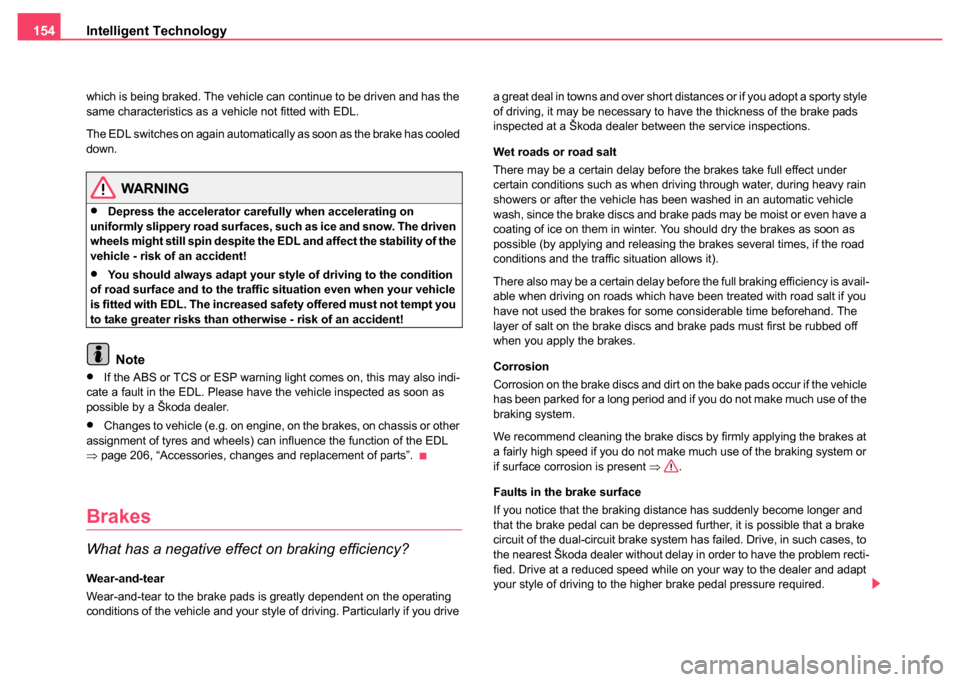
Intelligent Technology
154
which is being braked. The vehicle can continue to be driven and has the
same characteristics as a vehicle not fitted with EDL.
The EDL switches on again automatically as soon as the brake has cooled
down.
WARNING
•Depress the accelerator carefully when accelerating on
uniformly slippery road surfaces, such as ice and snow. The driven
wheels might still spin despite the EDL and affect the stability of the
vehicle - risk of an accident!
•You should always adapt your style of driving to the condition
of road surface and to the traffic situation even when your vehicle
is fitted with EDL. The increased safety offered must not tempt you
to take greater risks than otherwise - risk of an accident!
Note
•If the ABS or TCS or ESP warning li ght comes on, this may also indi-
cate a fault in the EDL. Please have the vehicle inspected as soon as
possible by a Škoda dealer.
•Changes to vehicle (e.g. on engine, on the brakes, on chassis or other
assignment of tyres and wheels) can influence the function of the EDL
⇒ page 206, “Accessories, changes and replacement of parts”.
Brakes
What has a negative effect on braking efficiency?
Wear-and-tear
Wear-and-tear to the brake pads is greatly dependent on the operating
conditions of the vehicle and your style of driving. Particularly if you drive a great deal in towns and over short distances or if you adopt a sporty style
of driving, it may be necessary to have the thickness of the brake pads
inspected at a Škoda dealer between the service inspections.
Wet roads or road salt
There may be a certain delay before the brakes take full effect under
certain conditions such as when driving through water, during heavy rain
showers or after the vehicle has been washed in an automatic vehicle
wash, since the brake discs and brake pads may be moist or even have a
coating of ice on them in winter. You should dry the brakes as soon as
possible (by applying and releasing the brakes several times, if the road
conditions and the traffic situation allows it).
There also may be a certain delay before the full braking efficiency is avail-
able when driving on roads which have been treated with road salt if you
have not used the brakes for some considerable time beforehand. The
layer of salt on the brake discs and brake pads must first be rubbed off
when you apply the brakes.
Corrosion
Corrosion on the brake discs and dirt on the bake pads occur if the vehicle
has been parked for a long period and if you do not make much use of the
braking system.
We recommend cleaning the brake discs by firmly applying the brakes at
a fairly high speed if you do not make much use of the braking system or
if surface corrosion is present
⇒.
Faults in the brake surface
If you notice that the braking distance has suddenly become longer and
that the brake pedal can be depressed further, it is possible that a brake
circuit of the dual-circuit brake system has failed. Drive, in such cases, to
the nearest Škoda dealer without delay in order to have the problem recti-
fied. Drive at a reduced speed while on your way to the dealer and adapt
your style of driving to the higher brake pedal pressure required.
Page 156 of 247
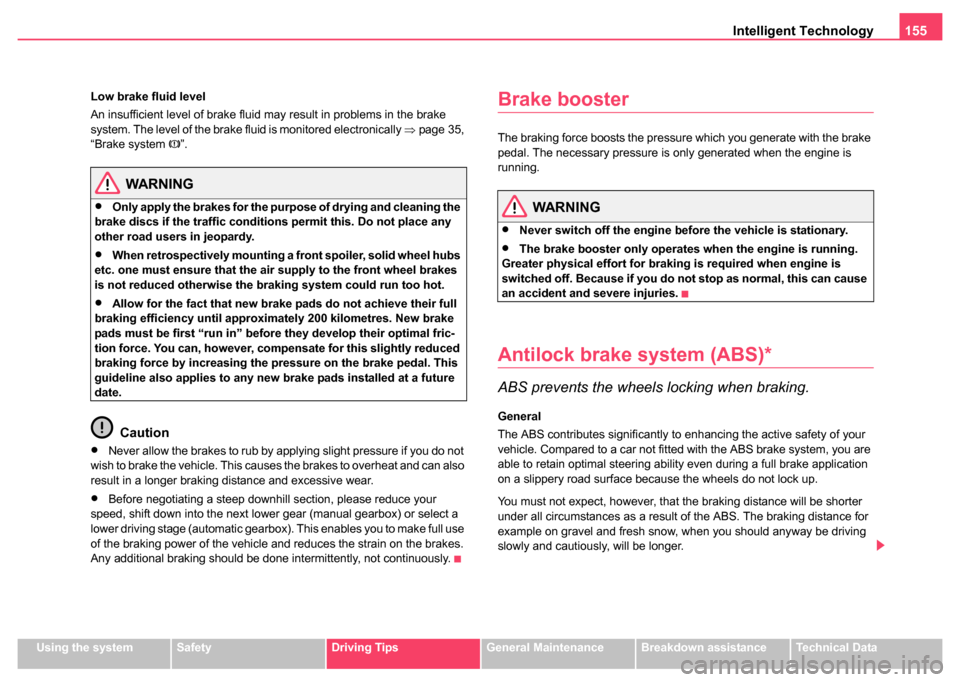
Intelligent Technology155
Using the systemSafetyDriving TipsGeneral MaintenanceBreakdown assistanceTechnical Data
Low brake fluid level
An insufficient level of brake fluid may result in problems in the brake
system. The level of the brake fluid is monitored electronically
⇒page 35,
“Brake system ”.
WARNING
•Only apply the brakes for the purpose of drying and cleaning the
brake discs if the traffic conditions permit this. Do not place any
other road users in jeopardy.
•When retrospectively mounting a front spoiler, solid wheel hubs
etc. one must ensure that the air supply to the front wheel brakes
is not reduced otherwise the braking system could run too hot.
•Allow for the fact that new brake pads do not achieve their full
braking efficiency until approximately 200 kilometres. New brake
pads must be first “run in” before they develop their optimal fric-
tion force. You can, however, compensate for this slightly reduced
braking force by increasing the pressure on the brake pedal. This
guideline also applies to any new brake pads installed at a future
date.
Caution
•Never allow the brakes to rub by applying slight pressure if you do not
wish to brake the vehicle. This causes the brakes to overheat and can also
result in a longer braking distance and excessive wear.
•Before negotiating a steep downhill section, please reduce your
speed, shift down into the next lower gear (manual gearbox) or select a
lower driving stage (automatic gearbox). This enables you to make full use
of the braking power of the vehicle and reduces the strain on the brakes.
Any additional braking should be done intermittently, not continuously.
Brake booster
The braking force boosts the pressure which you generate with the brake
pedal. The necessary pressure is only generated when the engine is
running.
WARNING
•Never switch off the engine before the vehicle is stationary.
•The brake booster only operates when the engine is running.
Greater physical effort for braking is required when engine is
switched off. Because if you do not stop as normal, this can cause
an accident and severe injuries.
Antilock brake system (ABS)*
ABS prevents the wheels locking when braking.
General
The ABS contributes significantly to enhancing the active safety of your
vehicle. Compared to a car not fitted with the ABS brake system, you are
able to retain optimal steering ability even during a full brake application
on a slippery road surface because the wheels do not lock up.
You must not expect, however, that the braking distance will be shorter
under all circumstances as a result of the ABS. The braking distance for
example on gravel and fresh snow, when you should anyway be driving
slowly and cautiously, will be longer.
Page 157 of 247
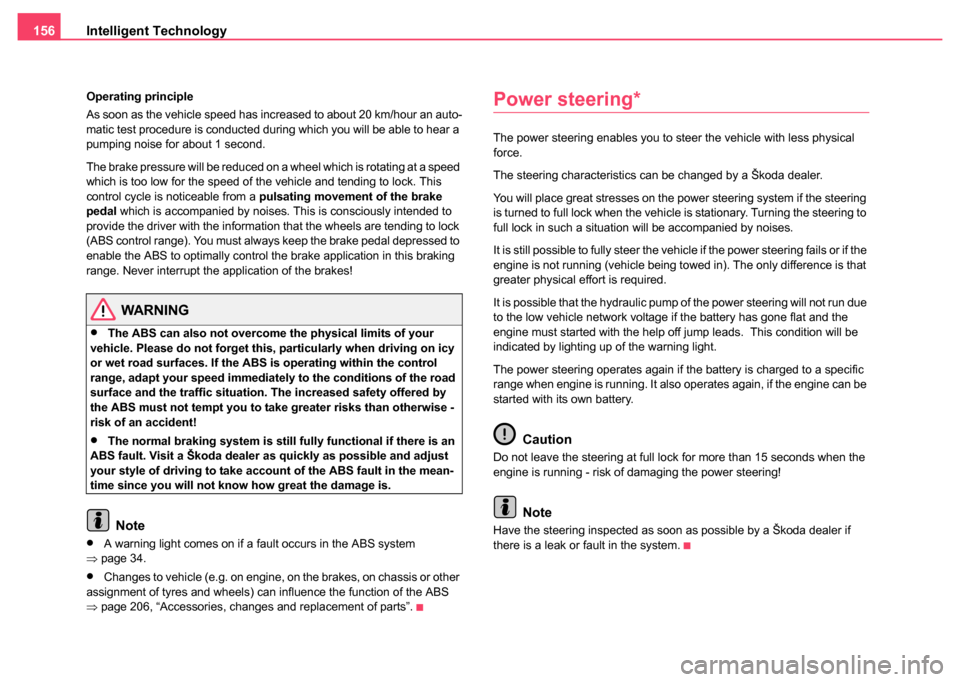
Intelligent Technology
156
Operating principle
As soon as the vehicle speed has increased to about 20 km/hour an auto-
matic test procedure is conducted during which you will be able to hear a
pumping noise for about 1 second.
The brake pressure will be reduced on a wheel which is rotating at a speed
which is too low for the speed of the vehicle and tending to lock. This
control cycle is noticeable from a pulsating movement of the brake
pedal which is accompanied by noises. This is consciously intended to
provide the driver with the information that the wheels are tending to lock
(ABS control range). You must always keep the brake pedal depressed to
enable the ABS to optimally control the brake application in this braking
range. Never interrupt the application of the brakes!
WARNING
•The ABS can also not overcome the physical limits of your
vehicle. Please do not forget this, particularly when driving on icy
or wet road surfaces. If the ABS is operating within the control
range, adapt your speed immediately to the conditions of the road
surface and the traffic situation. The increased safety offered by
the ABS must not tempt you to take greater risks than otherwise -
risk of an accident!
•The normal braking system is still fully functional if there is an
ABS fault. Visit a Škoda dealer as quickly as possible and adjust
your style of driving to take account of the ABS fault in the mean-
time since you will not know how great the damage is.
Note
•A warning light comes on if a fault occurs in the ABS system
⇒ page 34.
•Changes to vehicle (e.g. on engine, on the brakes, on chassis or other
assignment of tyres and wheels) can influence the function of the ABS
⇒ page 206, “Accessories, changes and replacement of parts”.
Power steering*
The power steering enables you to steer the vehicle with less physical
force.
The steering characteristics can be changed by a Škoda dealer.
You will place great stresses on the power steering system if the steering
is turned to full lock when the vehicle is stationary. Turning the steering to
full lock in such a situation will be accompanied by noises.
It is still possible to fully steer the vehicle if the power steering fails or if the
engine is not running (vehicle being towed in). The only difference is that
greater physical effort is required.
It is possible that the hydraulic pump of the power steering will not run due
to the low vehicle network voltage if the battery has gone flat and the
engine must started with the help off jump leads. This condition will be
indicated by lighting up of the warning light.
The power steering operates again if the battery is charged to a specific
range when engine is running. It also operates again, if the engine can be
started with its own battery.
Caution
Do not leave the steering at full lock for more than 15 seconds when the
engine is running - risk of damaging the power steering!
Note
Have the steering inspected as soon as possible by a Škoda dealer if
there is a leak or fault in the system.
Page 158 of 247
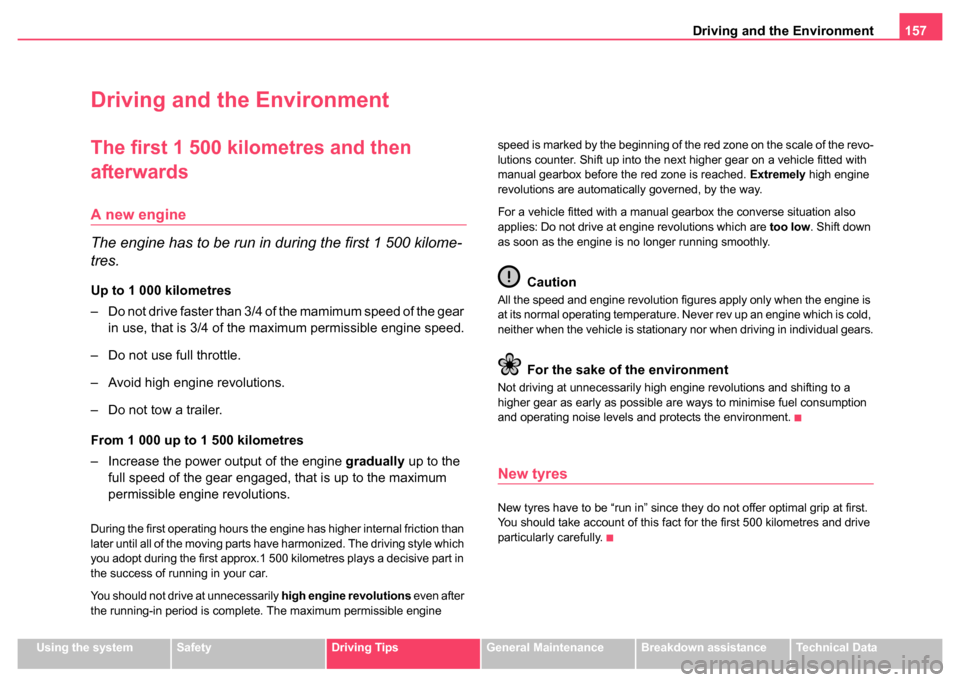
Driving and the Environment157
Using the systemSafetyDriving TipsGeneral MaintenanceBreakdown assistanceTechnical Data
Driving and the Environment
The first 1 500 kilometres and then
afterwards
A new engine
The engine has to be run in during the first 1 500 kilome-
tres.
Up to 1 000 kilometres
– Do not drive faster than 3/4 of the mamimum speed of the gear
in use, that is 3/4 of the maximum permissible engine speed.
– Do not use full throttle.
– Avoid high engine revolutions.
– Do not tow a trailer.
From 1 000 up to 1 500 kilometres
– Increase the power output of the engine gradually up to the
full speed of the gear engaged, that is up to the maximum
permissible engine revolutions.
During the first operating hours the engine has higher internal friction than
later until all of the moving parts have harmonized. The driving style which
you adopt during the first approx.1 500 kilometres plays a decisive part in
the success of running in your car.
You should not drive at unnecessarily high engine revolutions even after
the running-in period is complete. The maximum permissible engine speed is marked by the beginning of the red zone on the scale of the revo-
lutions counter. Shift up into the next higher gear on a vehicle fitted with
manual gearbox before the red zone is reached.
Extremely high engine
revolutions are automatically governed, by the way.
For a vehicle fitted with a manual gearbox the converse situation also
applies: Do not drive at engine revolutions which are too low. Shift down
as soon as the engine is no longer running smoothly.
Caution
All the speed and engine revolution figures apply only when the engine is
at its normal operating temperature. Never rev up an engine which is cold,
neither when the vehicle is stationary nor when driving in individual gears.
For the sake of the environment
Not driving at unnecessarily high engine revolutions and shifting to a
higher gear as early as possible are ways to minimise fuel consumption
and operating noise levels and protects the environment.
New tyres
New tyres have to be “run in” since they do not offer optimal grip at first.
You should take account of this fact for the first 500 kilometres and drive
particularly carefully.
Page 159 of 247
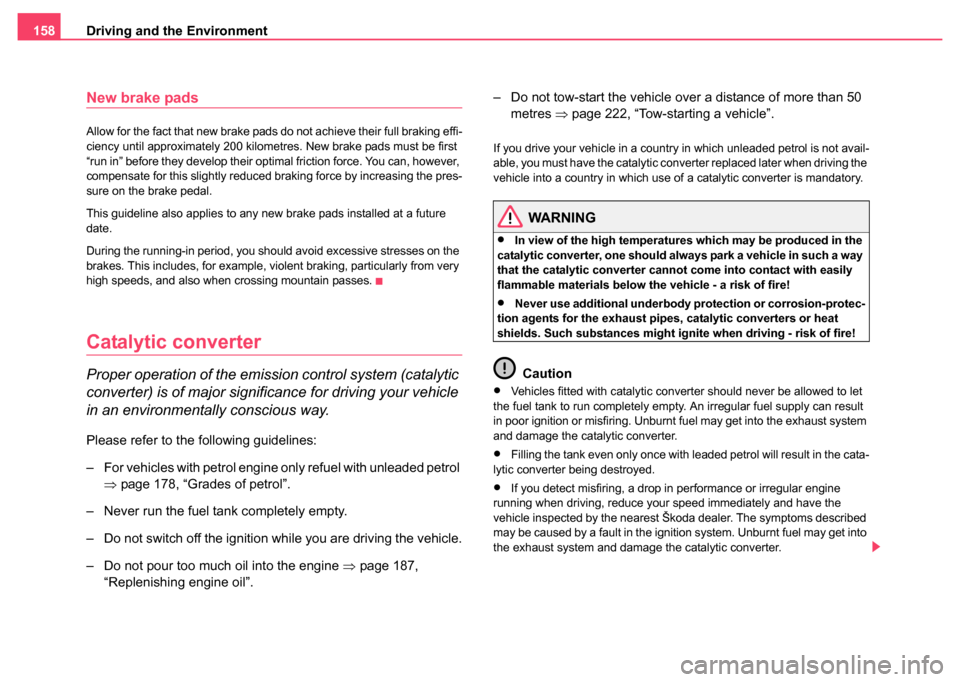
Driving and the Environment
158
New brake pads
Allow for the fact that new brake pads do not achieve their full braking effi-
ciency until approximately 200 kilometres. New brake pads must be first
“run in” before they develop their optimal friction force. You can, however,
compensate for this slightly reduced braking force by increasing the pres-
sure on the brake pedal.
This guideline also applies to any new brake pads installed at a future
date.
During the running-in period, you should avoid excessive stresses on the
brakes. This includes, for example, violent braking, particularly from very
high speeds, and also when crossing mountain passes.
Catalytic converter
Proper operation of the emission control system (catalytic
converter) is of major significance for driving your vehicle
in an environmentally conscious way.
Please refer to the following guidelines:
– For vehicles with petrol engine only refuel with unleaded petrol
⇒page 178, “Grades of petrol”.
– Never run the fuel tank completely empty.
– Do not switch off the ignition while you are driving the vehicle.
– Do not pour too much oil into the engine ⇒page 187,
“Replenishing engine oil”. – Do not tow-start the vehicle over a distance of more than 50
metres ⇒page 222, “Tow-starting a vehicle”.
If you drive your vehicle in a country in which unleaded petrol is not avail-
able, you must have the catalytic converter replaced later when driving the
vehicle into a country in which use of a catalytic converter is mandatory.
WARNING
•In view of the high temperatures which may be produced in the
catalytic converter, one should always park a vehicle in such a way
that the catalytic converter cannot come into contact with easily
flammable materials below the vehicle - a risk of fire!
•Never use additional underbody protection or corrosion-protec-
tion agents for the exhaust pipes, catalytic converters or heat
shields. Such substances might ignite when driving - risk of fire!
Caution
•Vehicles fitted with catalytic converter should never be allowed to let
the fuel tank to run completely empty. An irregular fuel supply can result
in poor ignition or misfiring. Unburnt fuel may get into the exhaust system
and damage the catalytic converter.
•Filling the tank even only once with leaded petrol will result in the cata-
lytic converter being destroyed.
•If you detect misfiring, a drop in performance or irregular engine
running when driving, reduce your speed immediately and have the
vehicle inspected by the nearest Škoda dealer. The symptoms described
may be caused by a fault in the ignition system. Unburnt fuel may get into
the exhaust system and damage the catalytic converter.
Page 160 of 247
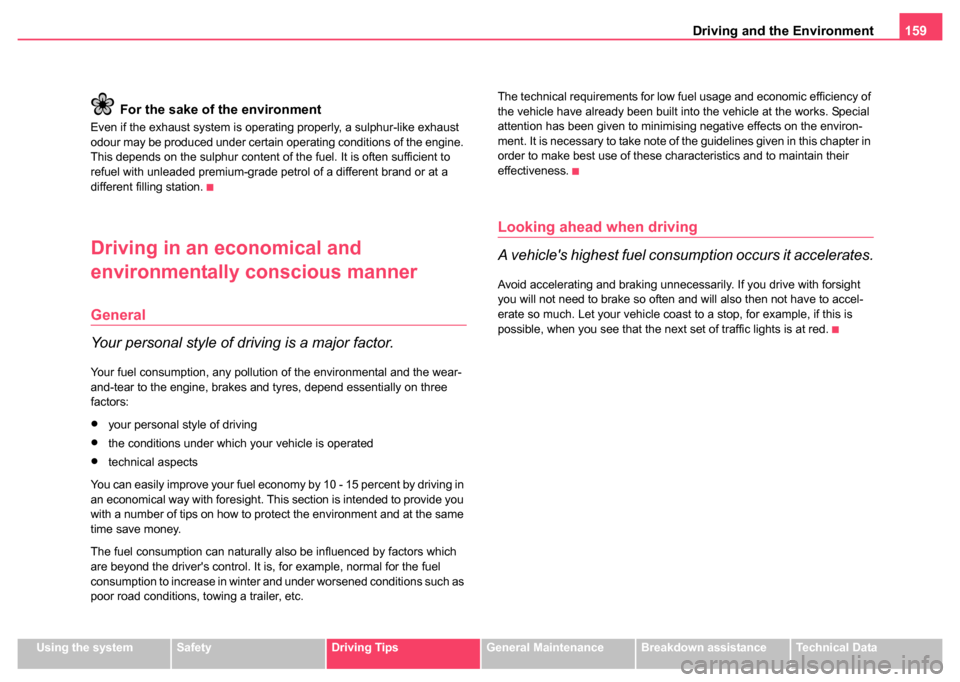
Driving and the Environment159
Using the systemSafetyDriving TipsGeneral MaintenanceBreakdown assistanceTechnical Data
For the sake of the environment
Even if the exhaust system is operating properly, a sulphur-like exhaust
odour may be produced under certain operating conditions of the engine.
This depends on the sulphur content of the fuel. It is often sufficient to
refuel with unleaded premium-grade petrol of a different brand or at a
different filling station.
Driving in an economical and
environmentally conscious manner
General
Your personal style of driving is a major factor.
Your fuel consumption, any pollution of the environmental and the wear-
and-tear to the engine, brakes and tyres, depend essentially on three
factors:
•your personal style of driving
•the conditions under which your vehicle is operated
•technical aspects
You can easily improve your fuel economy by 10 - 15 percent by driving in
an economical way with foresight. This section is intended to provide you
with a number of tips on how to protect the environment and at the same
time save money.
The fuel consumption can naturally also be influenced by factors which
are beyond the driver's control. It is, for example, normal for the fuel
consumption to increase in winter and under worsened conditions such as
poor road conditions, towing a trailer, etc. The technical requirements for low fuel usage and economic efficiency of
the vehicle have already been built into the vehicle at the works. Special
attention has been given to minimising negative effects on the environ-
ment. It is necessary to take note of the guidelines given in this chapter in
order to make best use of these characteristics and to maintain their
effectiveness.
Looking ahead when driving
A vehicle's highest fuel consumption occurs it accelerates.
Avoid accelerating and braking unnecessarily. If you drive with forsight
you will not need to brake so often and will also then not have to accel-
erate so much. Let your vehicle coast to a stop, for example, if this is
possible, when you see that the next set of traffic lights is at red.